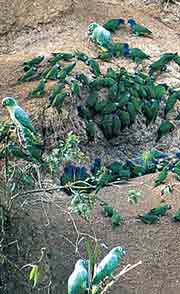The world's largest known mineral clay lick, where hundreds of parrots and macaws of up to 15 species congregate daily to ingest the detoxifying clay, is located less than 500 meters from Tambopata Research Center.

The 1994 National Geographic article on macaws begins with a vivid description of their activity at the Tambopata Research Center clay lick : " When the morning sun clears the Amazon tree line in southeastern Peru and strikes a gray-pink clay bank on the upper Tambopata River, one of the world´s most dazzling wildlife spectacles is nearing its riotous peak. The steep bank has become a pulsing, 130 foot high palette of red, blue, yellow and green as more than a thousand parrots squabble over choice perches to grab a beakful of clay, a vital but mysterious part of their diet. More than a dozen parrot species will visit the clay lick throughout the day, but this midmorning crush belongs to the giants of the parrot world, the macaws."
Clay licks, or "collpas" in Quechua, are simply high concentration deposits of minerals that are hard to come by in the rain forest. For parrots and macaws they come in the form of river bank clay deposits, but mammals sometimes gather around exposed soil in the ground, monkeys lick tree trunks with sediments and butterflies flutter about beaches where nutrient- rich liquids have evaporated. Clay licks are thus a widespread and not so uncommon phenomenon in the rain forest.
Without a doubt the most popular wildlife spectacle around Tambopata Research Center, and the one for which Tambopata is the most famous for is the macaw clay lick, less then 300 meters from the lodge itself. This particular clay lick is a huge, 50 meter tall cliff of reddish clay that extends for about 500 meters along the west bank of the Tambopata River. Although many clay licks are known to exist along the streams and rivers of the Tambopata Candamo Reserved Zone, the one in Tambopata is not only the largest known, but also the only one where Blue-and-gold macaws are known to descend to eat clay. On many clear mornings of the year, literally hundreds of parrots and macaws flock to the lick putting up what has been described by several well traveled celebrities that have witnessed it as one of the world's great wildlife spectacles.
Macaws and parrots not only come to the clay lick to obtain the hard to find minerals that are only present in high concentrations on the lick's soil. It is also thought that parrots eat the clay to neutralize the effects of toxic fruits and seeds that they eat. Finally, some scientists hypothesize that macaws also socialize and exchange information as they gather around the clay lick. Even though descending to the ground exposes the birds to danger, hundreds of parrots do it on most clear days, creating a racket that is audible hundreds of feet away. As they congregate in the crowns of trees surrounding the clay lick, the parrots spend hours at a time screeching, squabbling, gurgling and purring at each other before they decide to descend to eat the clay. Once they are on the lick itself, they concentrate on grabbing choice spots from which to feast on the clay. This is until they sense danger, usually in the form of an eagle, at which point they will depart simultaneously in a spectacular explosion of color and sound.
Six species of macaws and eleven species of parrots, parakeets and parrotlets come to the clay lick at Tambopata Research Center: Red-and-green, Blue-and-gold, Scarlet, Red-bellied, Chestnut-fronted and Blue-headed Macaws; Mealy and Yellow-crowned Amazons; Blue-headed, Orange-cheeked and White-bellied Parrots; Dusky-headed, White-eyed, Cobalt-winged and Tui Parakeets and Dusky-billed and Manu Parrotlets.


 The 1994 National Geographic article on macaws begins with a vivid description of their activity at the Tambopata Research Center clay lick : " When the morning sun clears the Amazon tree line in southeastern Peru and strikes a gray-pink clay bank on the upper Tambopata River, one of the world´s most dazzling wildlife spectacles is nearing its riotous peak. The steep bank has become a pulsing, 130 foot high palette of red, blue, yellow and green as more than a thousand parrots squabble over choice perches to grab a beakful of clay, a vital but mysterious part of their diet. More than a dozen parrot species will visit the clay lick throughout the day, but this midmorning crush belongs to the giants of the parrot world, the macaws."
The 1994 National Geographic article on macaws begins with a vivid description of their activity at the Tambopata Research Center clay lick : " When the morning sun clears the Amazon tree line in southeastern Peru and strikes a gray-pink clay bank on the upper Tambopata River, one of the world´s most dazzling wildlife spectacles is nearing its riotous peak. The steep bank has become a pulsing, 130 foot high palette of red, blue, yellow and green as more than a thousand parrots squabble over choice perches to grab a beakful of clay, a vital but mysterious part of their diet. More than a dozen parrot species will visit the clay lick throughout the day, but this midmorning crush belongs to the giants of the parrot world, the macaws."










